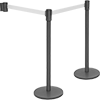Filter by
Color
Message
Mount Type
Message Type
DFARS Specialty Metals
Export Control Classification Number (ECCN)
Width
Length
Thickness
Message Color
Language
Visibility
Environment
Message Contains
Belt Pattern
Most Likely Products
All Results
Safety Equipment

Clearance Bars
Hang overhead to call attention to low-clearance areas, entrances, or exits
15 products
Communication
Electrical
Lighting
Building and Machinery Hardware























































